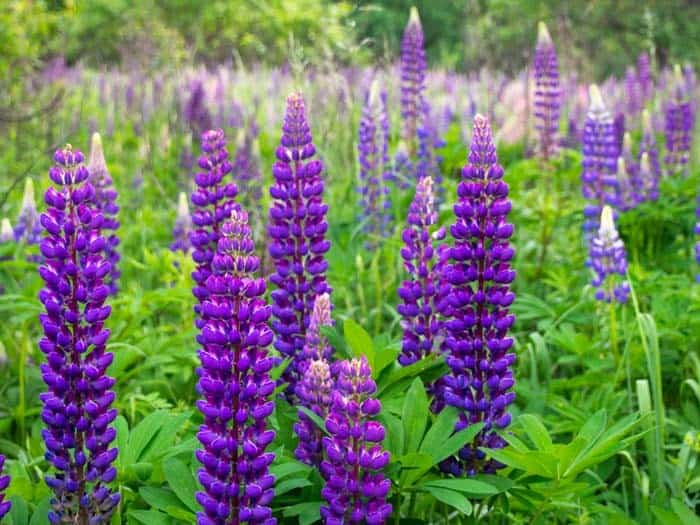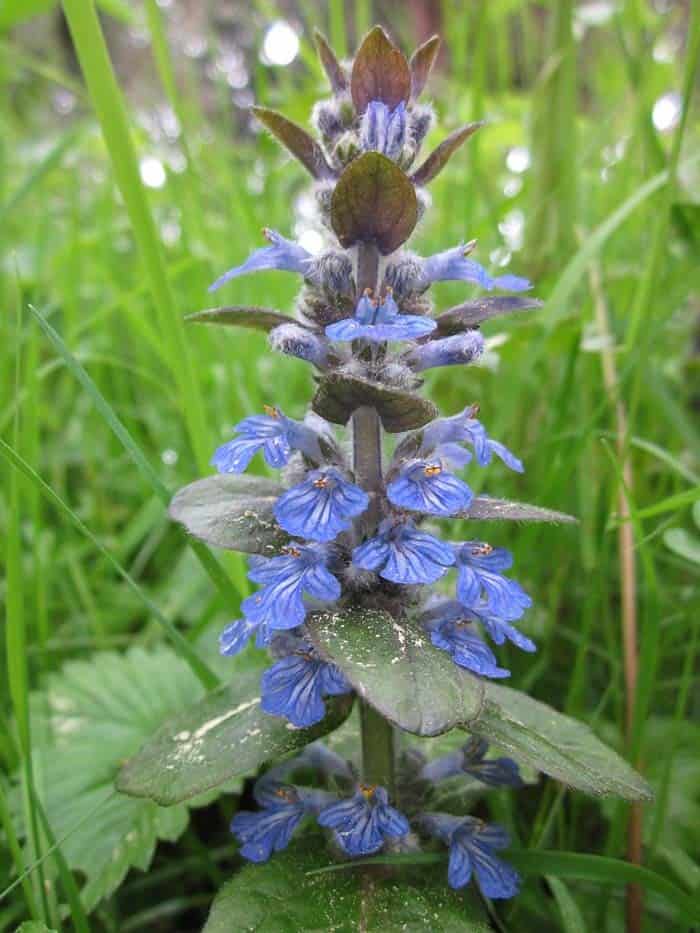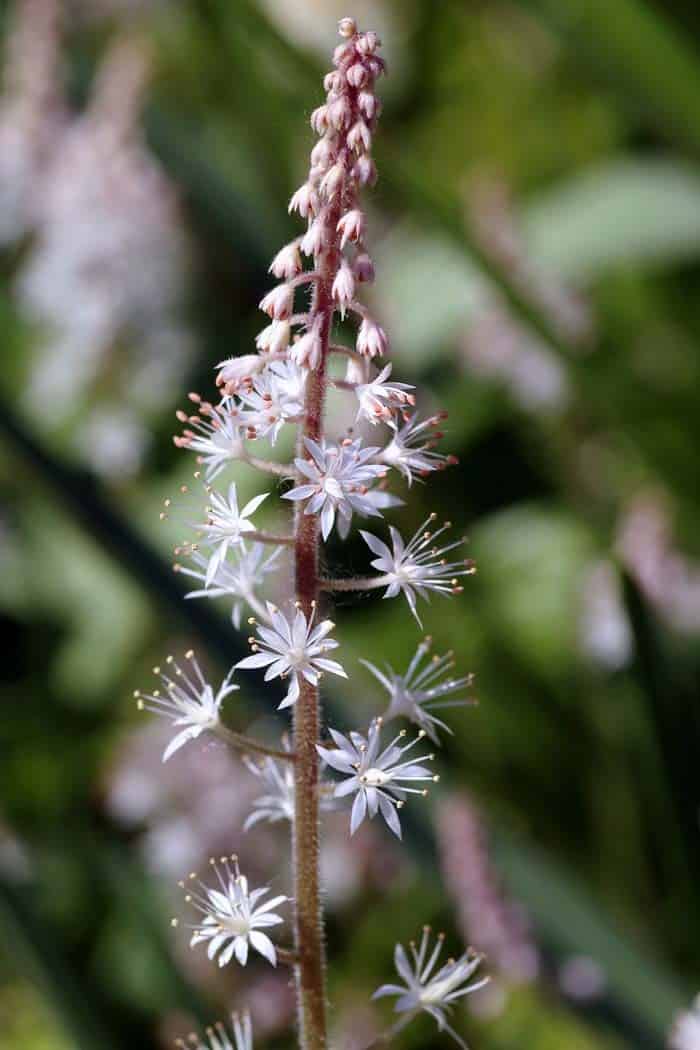Perennials are an excellent way to simplify gardening, as they require planting only once and return every year. However, many varieties have a limited flowering period of just a few weeks annually. To enjoy a prolonged blooming season, opt for perennials that produce flowers throughout the summer. This approach allows you to maintain a vibrant garden without the need for frequent replanting.
To make the most out of your perennial collection, consider purchasing a package like the Perennial Flower Garden Collection, which offers a range of flowering plants at an affordable price. For example, you can get a collection that includes Russell Lupine, Black-Eyed Susan, Shasta Daisy, Purple Coneflower, and Blue Columbine for as low as $10. Check out this offer HERE.
When growing perennials, keep the following tips in mind: Plant your perennials as soon as possible after receiving them to ensure they get established quickly. Amend your soil by adding peat moss or compost to improve its structure and fertility. Dig holes that are slightly larger than the root ball of each plant to provide adequate space for growth. Water your perennials regularly, especially during their first growing season.
Finally, in colder climates, consider mulching around the base of your plants to protect them from harsh winter conditions.
Alliums
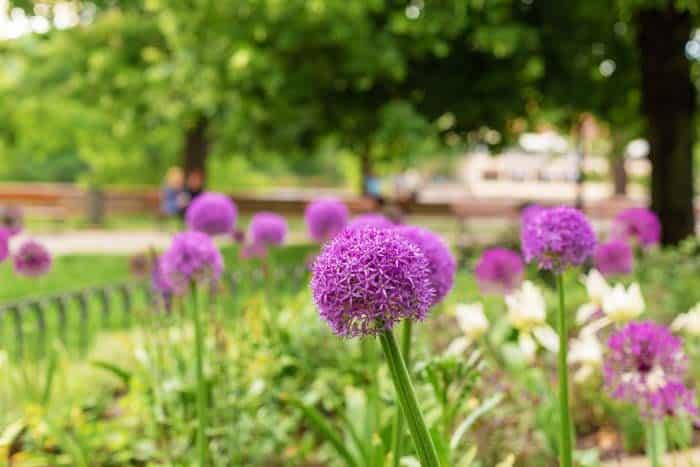
For a garden that commands attention, the allium is an ideal choice. Its unique growth habit begins with a slender stem rising above ground-cover plants, creating a striking visual contrast. As it blooms, the allium bursts into a stunning sphere of vibrant purple flowers, making a dramatic statement in any landscape. Whether bordering a house or situated in an open yard, this perennial flower is sure to impress.
Its blooming period spans from spring and early summer, with some varieties continuing to thrive well into late summer.
This showstopper thrives in USDA Growing Zones 4-8, where it can bask in full sun. It’s also remarkably resilient, tolerating drought and requiring only well-drained soil to flourish.
Coreopsis
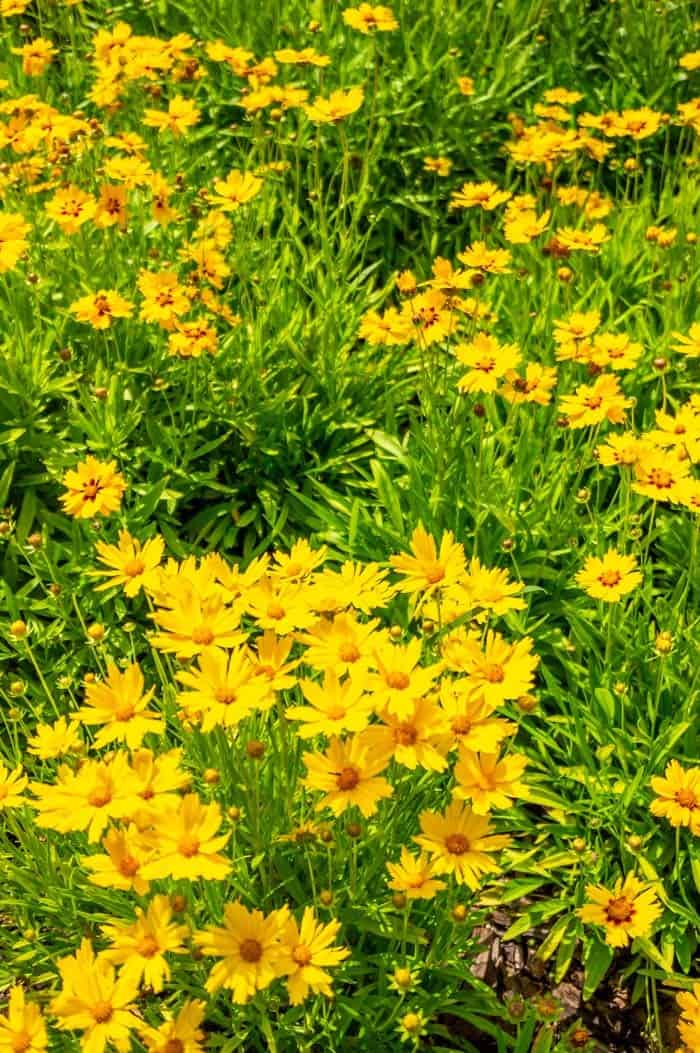
As the end of spring gives way to the warmth of summer, the coreopsis flower bursts with vibrant color and life. Its unique blooms feature jagged petal edges that add a playful touch to any garden or arrangement. With their ease of planting, growth, and cutting, it’s no wonder coreopsis is a beloved choice among summer flowers. This versatile bloom thrives in USDA zones 3-9, tolerates dry to medium-moisture soil, and basks in full sun.
While yellow is the most iconic color variety, hybrids and cultivars also offer pink, red, and bi-colored options for added visual interest.
Blue Lupine
Enhance the visual appeal of your garden by incorporating blue lupine flowers, which can add a touch of wild charm. These delicate blooms grow in conical shapes and maintain their beauty for an extended period, making them an excellent perennial choice. Not only do they thrive in English gardens, but they also complement relaxed yard settings. With proper care, blue lupines can grow successfully in USDA zones 4 to 8. The flowers come in a lovely violet-blue hue and require full sun exposure.
To ensure optimal growth, plant them in medium-moisture soil with good drainage.
Dahlias
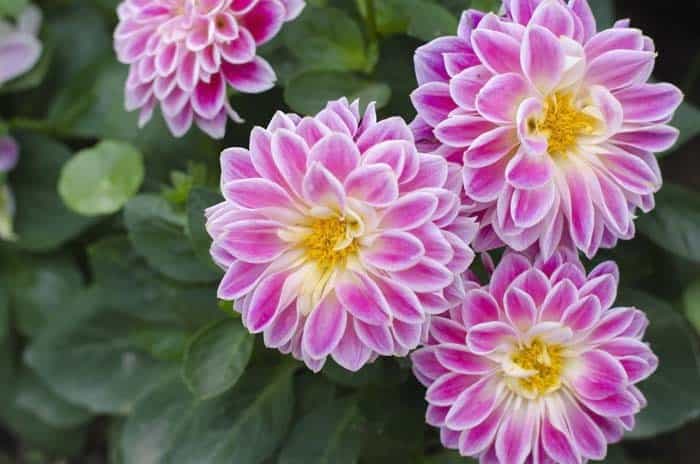
Dahlias are truly showstoppers in any garden, boasting an array of intricate, layered petals that evoke a sense of luxury. For the longest blooming period, consider Friquolet, which thrives from early summer to fall, providing a constant kaleidoscope of colors. A surprising benefit of pruning dahlias is that it actually stimulates new growth and encourages even more vibrant blooms.
These statement flowers are best suited for USDA Growing Zones 8-10 and prefer conditions of full sun, medium-moisture soil with good drainage. The color palette is equally impressive, featuring pink, purple, red, scarlet, orange, yellow, and white varieties.
Bugleweed
While bugleweed may not be the most glamorous addition to your perennial garden, its diminutive yet vibrant blooms are sure to win you over. In fact, this low-growing beauty is a perfect solution for adding life to shady spots and filling in gaps between larger plants like hedges or bushes. Plus, it’s incredibly easy to care for, thriving in conditions that include full sun, partial shade, and medium-moisture soil.
So, if you’re looking for a reliable, low-fuss option to add some color to your outdoor space, bugleweed is definitely worth considering.
Catmint
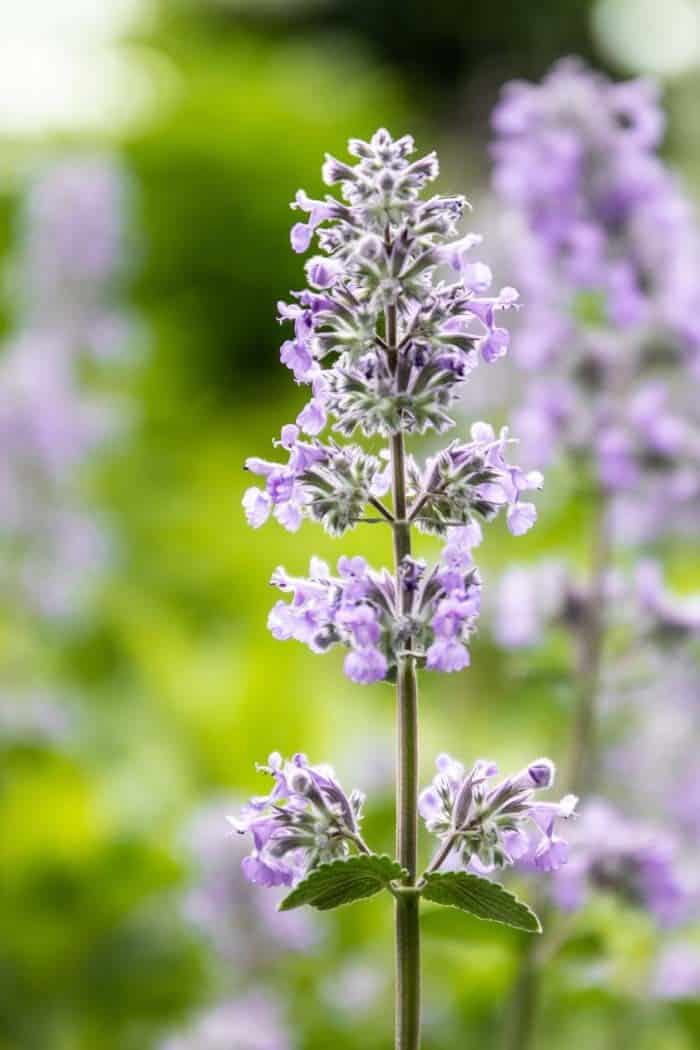
For a lush and full display that can cover a significant area, the Walker’s Low catmint plant is an excellent choice. Characterized by compact leaves and a profusion of flowers that densely clothe the stem, this variety boasts a remarkably verdant appearance. While most plants typically reach heights of around 2 feet, some varieties can grow up to 30 inches in ideal conditions.
When it comes to growing conditions, Walker’s Low catmint thrives in USDA zones 4-8 and requires full sun to partial shade. The soil should be well-drained and have a dry to medium-moisture content.
Cranesbill Geranium
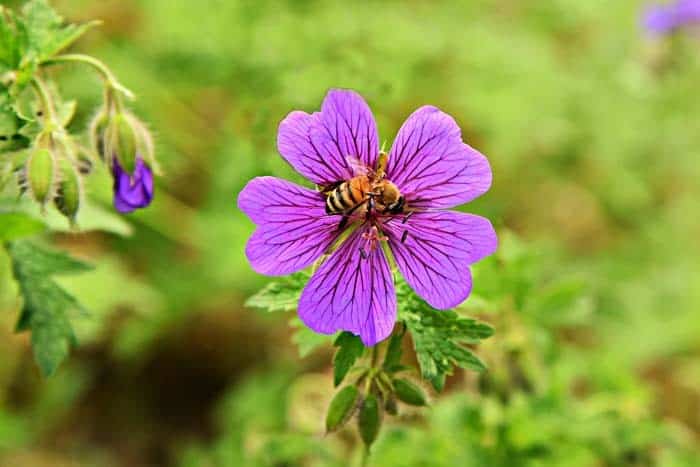
The Cranesbill geranium is a standout choice for summer blooms, offering a dramatic display from late spring to mid-summer. But that’s not all – with some simple maintenance, you can enjoy another vibrant flush of color near the end of August. This hardy perennial thrives in USDA zones 4 to 10, where it can bask in full sun to part shade and grow well in medium-moisture soils.
Creeping Thyme
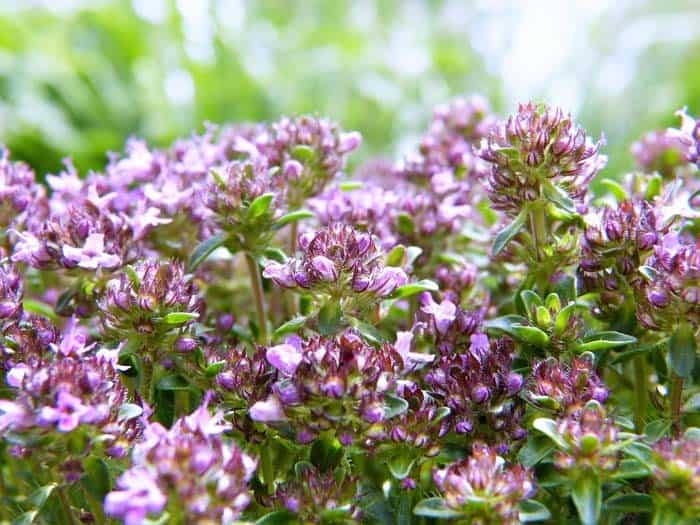
Transform your garden into a lush oasis by incorporating creeping thyme into your landscaping plan. These charming plants boast dainty leaves and diminutive flowers with intricate details. As they spread, creeping thyme forms an abundance of ground cover, providing a naturalistic appearance. Plus, you can harvest the fragrant greens for culinary use.
For optimal growth, creeping thyme thrives in USDA zones 4 to 9, under full sun to partial shade.
The soil requirements are moderate moisture levels, with regular watering.
Dianthus
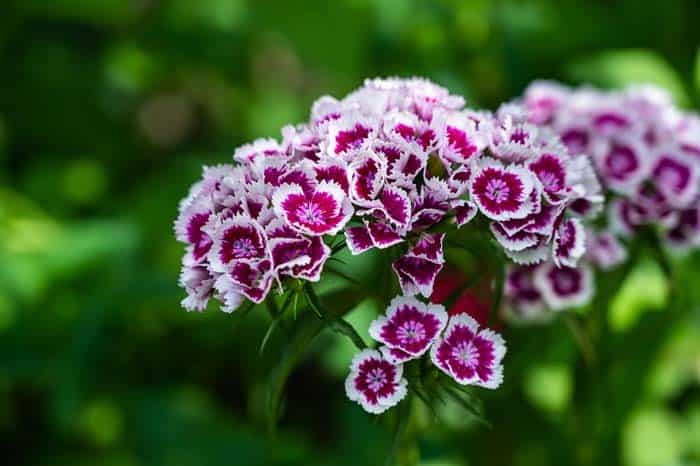
Dianthus flowers are a perennial delight, boasting vibrant blooms for months on end. This stunning feature makes them an ideal addition to your garden, particularly if you’re seeking a diverse range of colors. With their ability to thrive in direct sunlight, these hardy flowers are perfect for spots that receive full sun or partial shade. When it comes to growing conditions, dianthus plants require a medium-moisture soil and regular watering.
As per the USDA, they can be grown in zones 4 through 9. Furthermore, their color palette is nothing short of breathtaking, featuring a range of hues including red, pink, rose, lavender, white, and yellow, with some varieties even offering bi-colored blooms.
Foam Flower
The foam flower earns its name from the striking resemblance of its cluster of cone-shaped blooms to a light and airy layer of foam. As you gaze upon these delicate perennials, you’ll notice that the translucent petals appear almost ethereal, as if suspended in mid-air. These charming flowers are well-suited for both wild spaces and traditional cottage gardens. They thrive in USDA Growing Zones 4 to 9, where they can bask in partial or full shade.
A consistent supply of moist soil is also crucial for their growth.
Geranium Rozanne
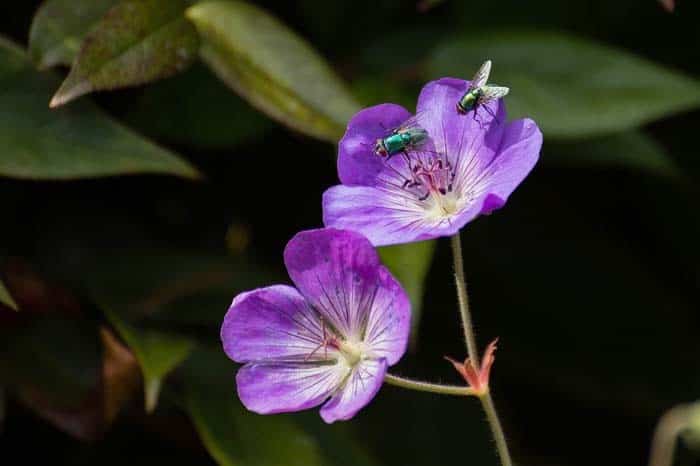
While geraniums are a familiar sight for many gardeners, the Rozanne variety is sure to turn heads with its vibrant blooms. This low-maintenance perennial thrives in full-sun areas, making it perfect for adding a pop of color to even the most neglected corners of your outdoor space. One of its best qualities? Its ability to withstand critter attacks, as rabbits and deer tend to leave the flowers alone.
As a result, you can enjoy your blooms for longer without worrying about pesky pests ruining the show.
When it comes to growing conditions, Rozanne geraniums are adaptable to USDA zones 4 through 10. They come in a range of purple hues, and prefer full sun to part shade. Medium-moisture soil is also a must-have for these lovely perennials.
Gerbera Daisies
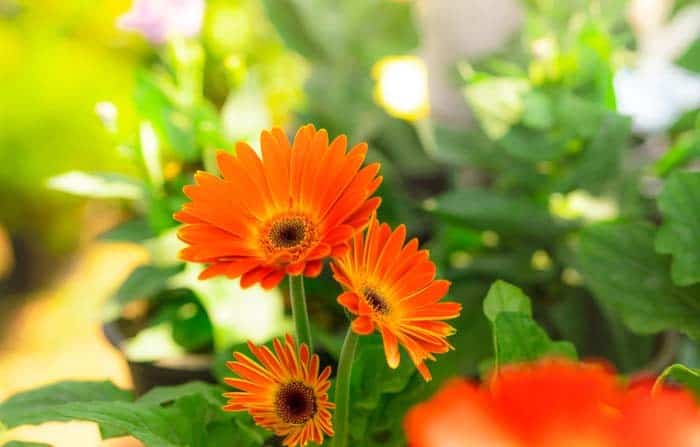
Gerbera daisies are a common sight in flower shops, but have you ever attempted to cultivate them yourself? These stunning blooms boast vibrant hues and intricate petal layers that seem almost too beautiful to be true. In reality, gerbera daisies are relatively low-maintenance, thriving in conditions suitable for most gardeners (USDA zones: all). With proper care, your garden will be awash with their colorful presence from late spring to early fall.
The ideal growing environment features full sun and dry, well-drained soil that can tolerate drought. You’ll have the opportunity to enjoy a wide range of colors, including yellow, white, pink, red, orange, lavender, salmon, and bicolored varieties.
Stella De Oro Daylily
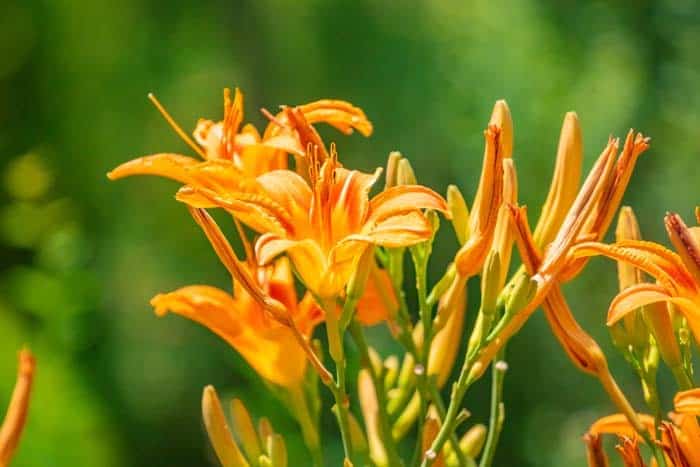
As you watch the Stella De Oro daylily’s blooms unfold, don’t be surprised if each flower has a remarkably short lifespan of just one day. This sunny perennial makes up for its fleeting beauty by producing an abundance of flowers throughout late spring and mid-summer, ensuring there’s always something new to admire. The sweet fragrance emitted by each bloom is the perfect accompaniment to this visual treat.
For optimal growth, Stella De Oro daylilies thrive in USDA zones 3 through 10, where they can bask in full sun to partial shade. A medium-moisture, well-drained soil provides the perfect foundation for these vibrant blooms, which come in a range of colors including yellow, gold, and bi-colors.
Hostas
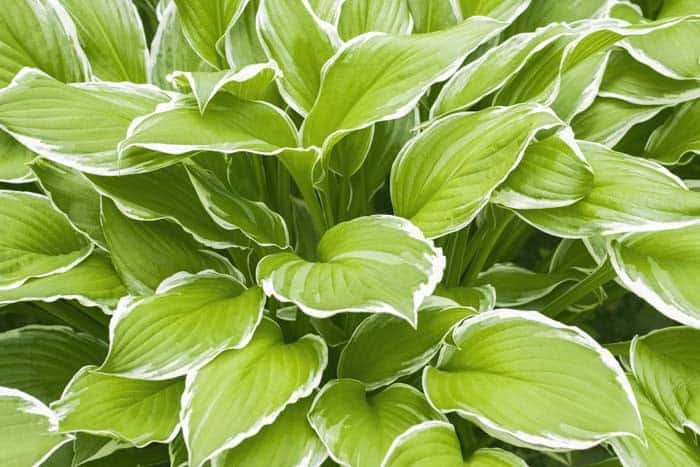
When your garden receives minimal sunlight, don’t worry! Hostas are the perfect solution. These perennial plants excel in partial shade and can even survive with no direct sunlight at all. While they’re renowned for their large leaves, they also produce dainty blooms that persist for months on end.
A useful guideline to keep in mind when selecting and caring for hostas is that lighter foliage tends to thrive in brighter conditions, whereas deeper, darker foliage retains its color best in moderate shade. For optimal growth, ensure you’re working within USDA Growing Zones 3 to 8. As for the color palette, you can expect a range of green-white hues. In terms of sunlight, hostas do well with filtered sun or partial shade. When it comes to soil needs, just remember to water regularly.
Hydrangeas
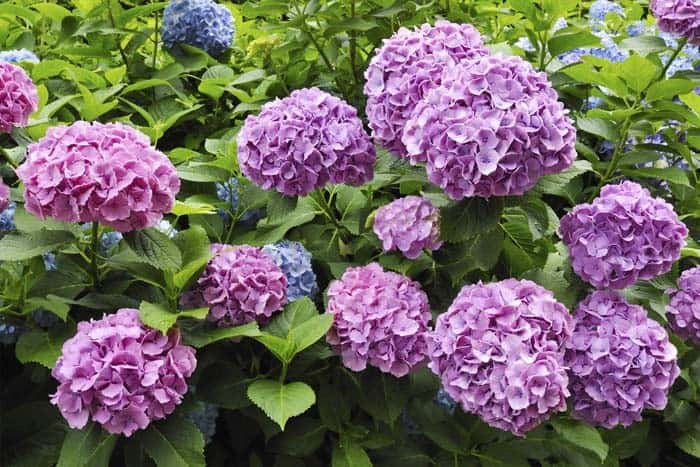
To maintain a stunning garden appearance throughout the year, consider the Summer Crush hydrangea. This variety produces vibrant, rounded clusters of purple or blue flowers that add an explosion of color to your outdoor space. Not only do these blooms provide visual interest during the warmer months, but the plant’s lush greenery also remains intact until the new flower buds emerge in the spring, following a winter dormant period.
For optimal growth and blooming, Summer Crush hydrangeas thrive in USDA zones 3-9, preferring medium-moisture, well-drained soil and adapting to various sun exposures, including filtered sun, full sun, partial shade, or partial sun. The flowers themselves come in an array of colors, ranging from pink and blue to lavender, violet, and purple, as well as green and white, offering a versatile palette for garden design enthusiasts.
Ice Plant

If you’re looking for a compact perennial that requires minimal maintenance, consider the ice plant. This low-growing gem typically reaches a height of only 6 inches, making it perfect for small spaces or as a groundcover. The tiny, delicate flowers emerge in early summer and remain fresh until fall, creating a lush display. With its carefree nature, the ice plant is an excellent choice for busy gardeners who want to enjoy the beauty of blooming plants without the hassle.
This low-maintenance perennial thrives in USDA zones 5-10 and can tolerate full sun. Its vibrant red-purple hues add a pop of color to any landscape. To keep your ice plant happy, provide dry, well-drained soil and it will do just fine, even withstanding drought conditions.
Lavender
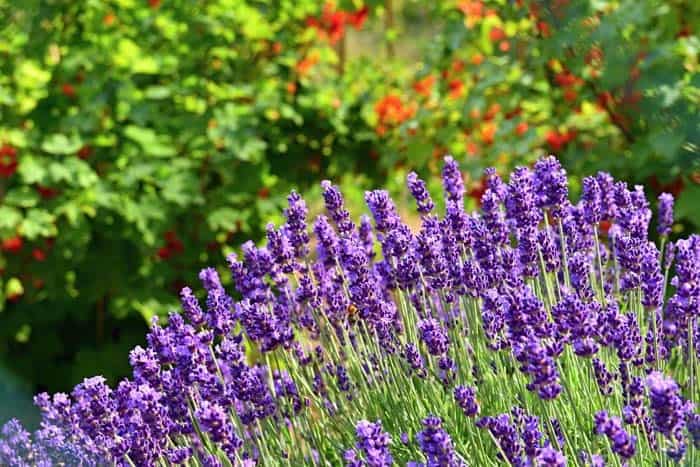
Imagine strolling through your own garden, surrounded by the sweet aroma of blooming lavender. This perennial beauty is a must-have for any outdoor enthusiast, boasting its signature color and intoxicating fragrance. English lavender stands out for its extended flowering season, which can last all summer long. With proper care, you can enjoy this lovely plant in USDA zones 4 to 9, depending on the specific cultivar.
Lavender also comes in a range of colors, including purple, blue, and even pink varieties, making it easy to find one that suits your style. When it comes to growing conditions, lavender prefers full sun and dry to medium-moisture soil with good drainage – just be mindful of overwatering, which can lead to root rot.
Monroe’s White Lilyturf
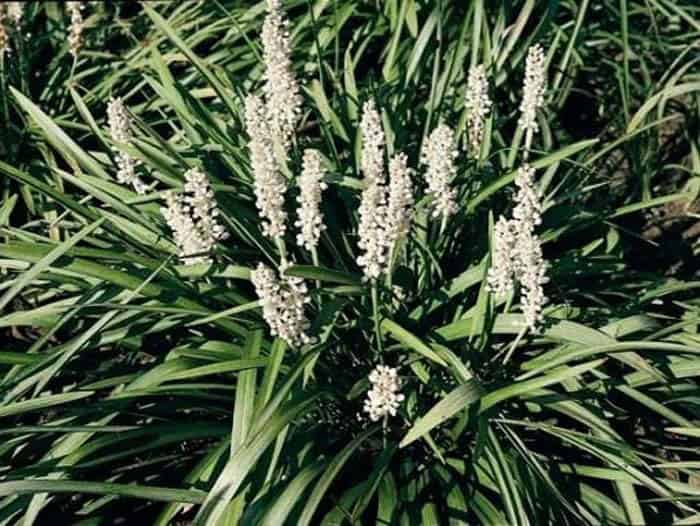
Elevate your perennial game with the Monroe White lilyturf, an unconventional yet captivating beauty. Its unique charm begins with a lush display of oversized, grass-like foliage that sets the stage for its impressive blooms. As the plant matures, it produces tall spikes adorned with rounded flowers that remain in bloom for months on end.
For optimal growth and flowering, the Monroe White lilyturf thrives in USDA zones 5 to 11, where it can be planted in areas receiving partial sun.
A well-drained soil with a dry to medium-moisture profile is also essential for this stunning perennial’s success.
Peonies
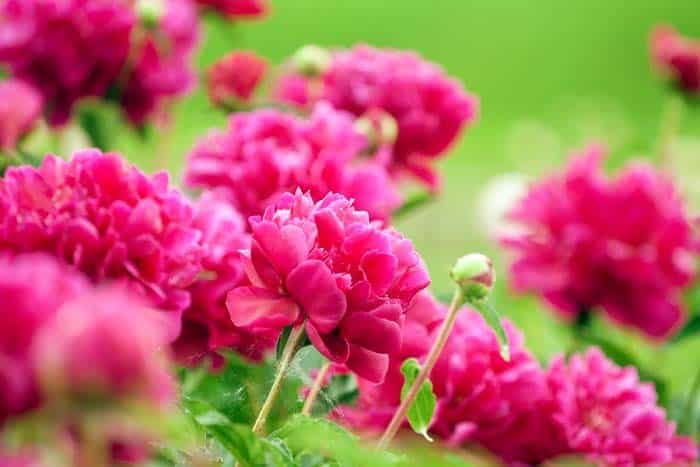
Peonies have won the hearts of many gardeners with their stunning appearance. These flowers thrive in warm temperatures, allowing you to enjoy an extended period of fragrant blooms from early spring to mid-summer by selecting a mix of varieties that cater to different conditions. While they require some care, peonies are relatively low-maintenance and can tolerate partial sun. They’re also adaptable to various soil types as long as they receive consistent watering.
Garden Phlox
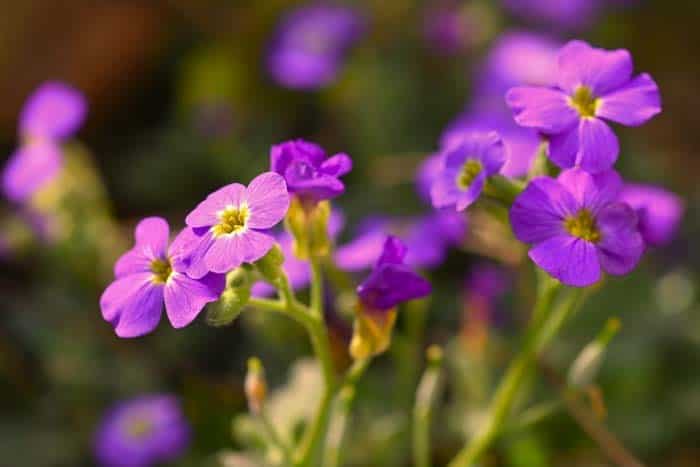
A garden phlox is a stunning addition to any traditional or cottage garden, boasting delicate petals and vibrant blooms. Its versatility allows it to thrive in a variety of settings, such as a flower bed surrounded by other summer-blooming plants, creating a striking accent for your summer garden. Alternatively, you can create a picturesque perennial border with this lovely plant. The phlox begins blooming in July, with the display continuing until fall, provided temperatures remain moderate.
For those seeking a low-fuss garden, consider the David phlox, which is resistant to mildew. This reliable performer thrives in USDA zones 4-8 and can tolerate a range of sunlight conditions, from full sun to partial shade. It’s equally at home in soil that’s medium-moisture to well-drained, making it an excellent choice for gardeners with varying levels of care.
Astilbe
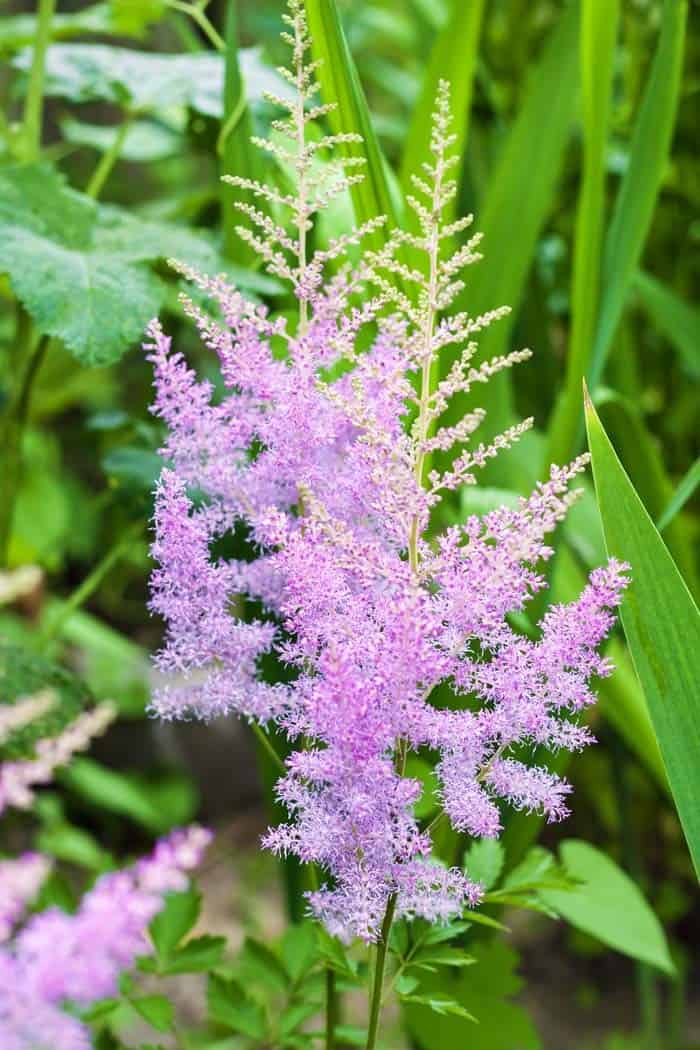
Indulge in the ethereal charm of astilbe, a perennial that exudes elegance and refinement. Delicate branches adorned with tiny pastel flowers create a whimsical ambiance, perfect for adding a touch of serenity to your outdoor oasis. As you gaze upon these blooms, the air is infused with an intoxicating fragrance, further enhancing the sensory experience.
When it comes to growing conditions, astilbe thrives in USDA zones 4-9, where it can be cultivated in a range of lighting scenarios, from filtered sun to full shade. To keep this perennial happy and healthy, ensure consistent watering to meet its moderate soil needs.
Purple Coneflower
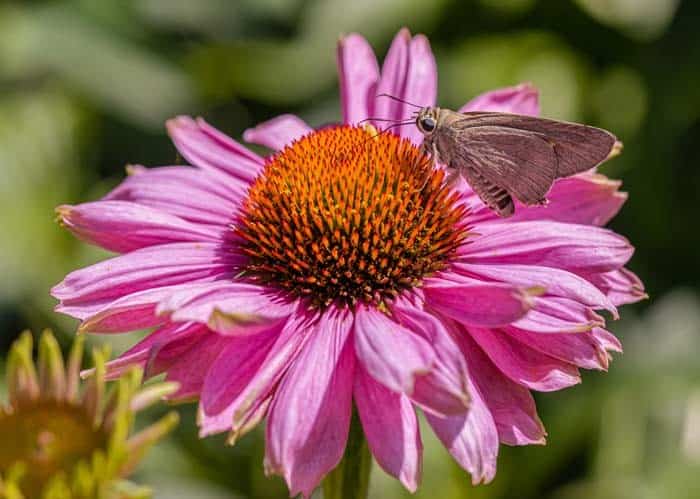
The purple coneflower is a showstopper with its striking cone-shaped center rising above the petals. If you love the classic look of a daisy but want more color and height, this flower is an excellent choice. When paired with an annual like sunflower, it creates a stunning visual display. Some varieties can grow up to 5 feet tall, making them a great option for adding drama to your garden. Plus, they’re low maintenance and bloom throughout the summer.
Whether you’re looking to add some purple flair or opt for one of the many color variations available, the coneflower is sure to please. When it comes to growing conditions, this flower thrives in USDA zones 3-9, depending on the specific variety. You’ll find a range of colors to choose from, including purplish pink as well as cultivars that offer white, orange, yellow, red, and green options.
The coneflower requires full sun to partial shade and prefers dry to medium-moisture soil with good drainage. Its drought tolerance makes it an excellent choice for gardeners who want a low-fuss flower that can still bring plenty of beauty to their outdoor space.
Rudbeckia
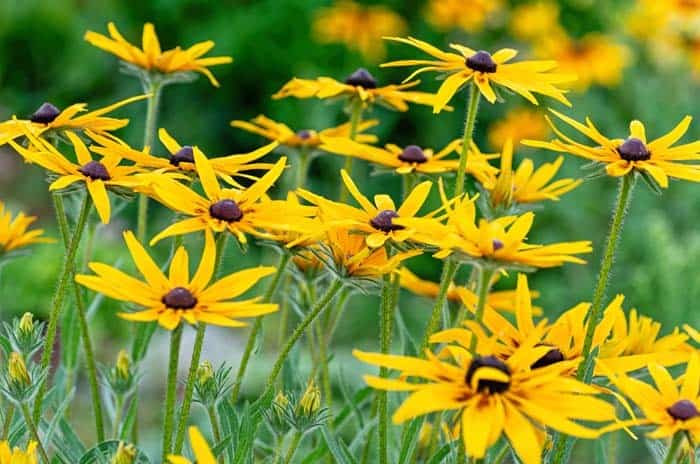
The Rudbeckia, also known as the Black-Eyed Susan, is a resilient and low-maintenance perennial that thrives in challenging climates. Its striking flowers boast vibrant petals that contrast elegantly with their dark centers, creating a bold visual effect.
This flower variety excels in USDA growing zones 3 to 7, where it can flourish in full sun. The colors range from sunny yellow to warm orange, all punctuated by the rich darkness of its centers.
Furthermore, Rudbeckia exhibits good tolerance for drought and prefers medium-moisture, well-drained soil.
Salvia
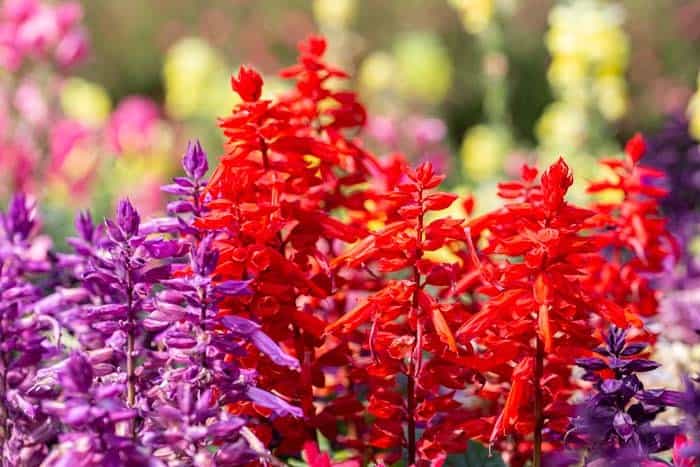
Salvia’s blooming period is notable for its prolonged duration, as long as you commit to regular deadheading. This allows the plant to thrive and bloom continuously for several months. With numerous varieties to select from, you can find a Salvia that suits your desired color palette and aesthetic. In terms of growing conditions, Salvia is adaptable to a wide range of environments, thriving in USDA zones 4 to 10 depending on the specific species.
The flowers themselves come in an array of blues and violets, adding a pop of color to any garden or arrangement. To maximize its growth, provide full sun exposure and plant it in dry to medium-moisture soil that drains well.
Sedum
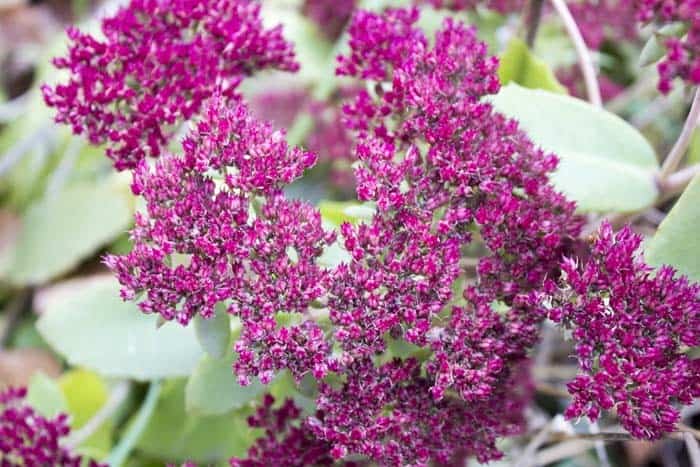
The Voodoo sedum variety is perfect for adding structure to a garden that feels too soft and romantic. Its unique foliage features crisp edges, while its flowers produce clusters of spiky petals that add visual interest. As low-maintenance perennials, they thrive in sunlight and require minimal watering efforts.
To grow these beauties, you’ll want to choose a spot with full sun or partial shade, depending on your personal preference.
The soil should be dry to medium-moisture and well-drained, allowing the roots to breathe. With USDA growing zones ranging from 3 to 9, this sedum variety is suitable for many regions. Additionally, you can enjoy the flowers in a range of colors including pink, purple, and coral.
Shasta Daisies
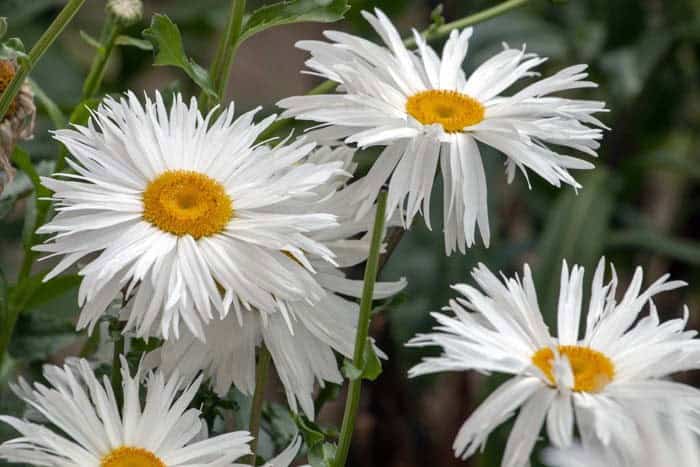
The Shasta daisy is renowned for its prolonged blooming period, which spans from early spring to mid-fall. This vibrant perennial’s classic charm and cheerful demeanor make it an ideal choice for areas that receive direct sunlight. Moreover, it’s a low-maintenance option that can thrive in a variety of conditions, including those with limited time for upkeep. In fact, its ability to return year after year makes it an excellent choice for busy gardeners.
The Shasta daisy is suitable for USDA Growing Zones 5-9 and prefers well-draining soil with moderate moisture levels. It’s particularly tolerant of drought, making it an attractive option for those seeking a hardy and resilient addition to their outdoor spaces. Its flowers are characterized by a white petals with yellow centers, adding a pop of color to any garden setting.
White Trillium
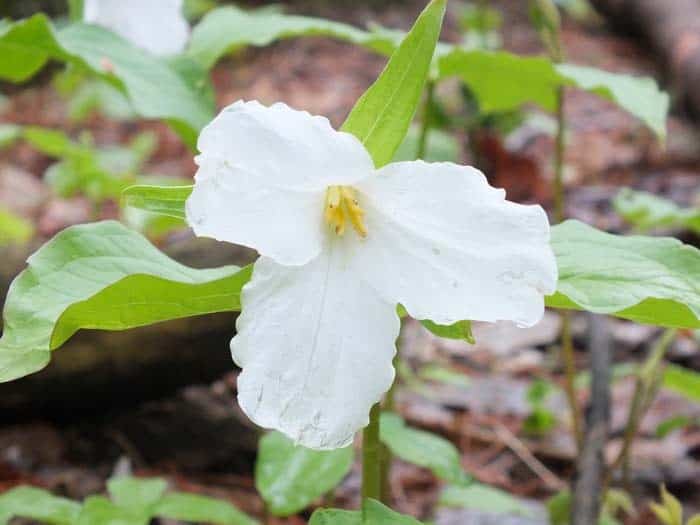
Indulge in the elegance of your summer garden by planting the striking white trillium. This charming flower boasts three prominent petals that are sure to captivate. Its blooms persist for several months, while its vibrant leaves maintain their beauty throughout the season. With a broad range of USDA growing zones from 4 to 9, you can easily incorporate this lovely addition into your outdoor space.
The white trillium’s striking appearance is further enhanced by its yellow-centered blooms and medium-moisture soil requirements. Enjoy the full sun or partial shade that suits your taste.
White Yarrow
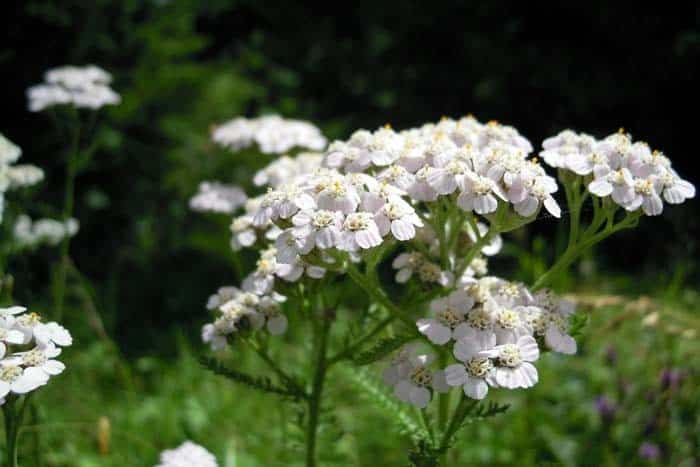
Yarrow’s unassuming appearance belies its rich history as a staple in natural medicine for thousands of years. This versatile herb boasts towering stems that can reach up to 3 feet tall, making it an excellent addition to any perennial garden. With proper deadheading, yarrow produces an abundance of flowers from late spring through early fall, adding a pop of color and vibrancy to your outdoor space. When it comes to growing conditions, yarrow is surprisingly adaptable.
It thrives in USDA Growing Zones 3-8 and can tolerate a range of sun exposures, from full sun to partial shade. Its soil needs are equally accommodating, preferring dry to medium-moisture, well-drained soil that’s resistant to drought.
Yellow Hollyhocks
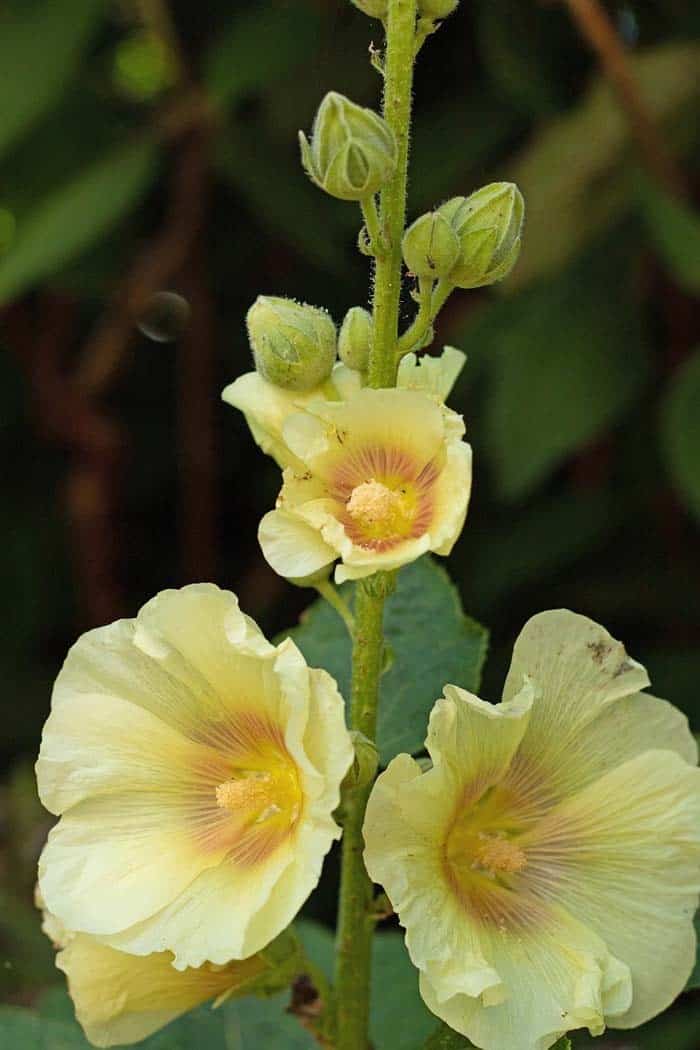
Hollyhocks’ delicate, multi-layered petals evoke a whimsical charm reminiscent of tissue-paper flowers. Despite their grandeur, the blooms exude an effortless elegance, making them an ideal choice for creating a charming border around a farmhouse or cottage. Their airy, hardy nature ensures that you’ll be treated to their beauty throughout the summer months. For optimal results, plant Hollyhocks in a sunny location where they can soak up the warmth.
These perennials thrive in USDA Growing Zones 3 to 8 and come in a range of colors including yellow, purple, and red. They require full sun and tolerate dry to medium-moisture soil conditions. I’m thoroughly smitten with these summer-blooming perennials and can’t wait to start planting as soon as the weather warms up!
